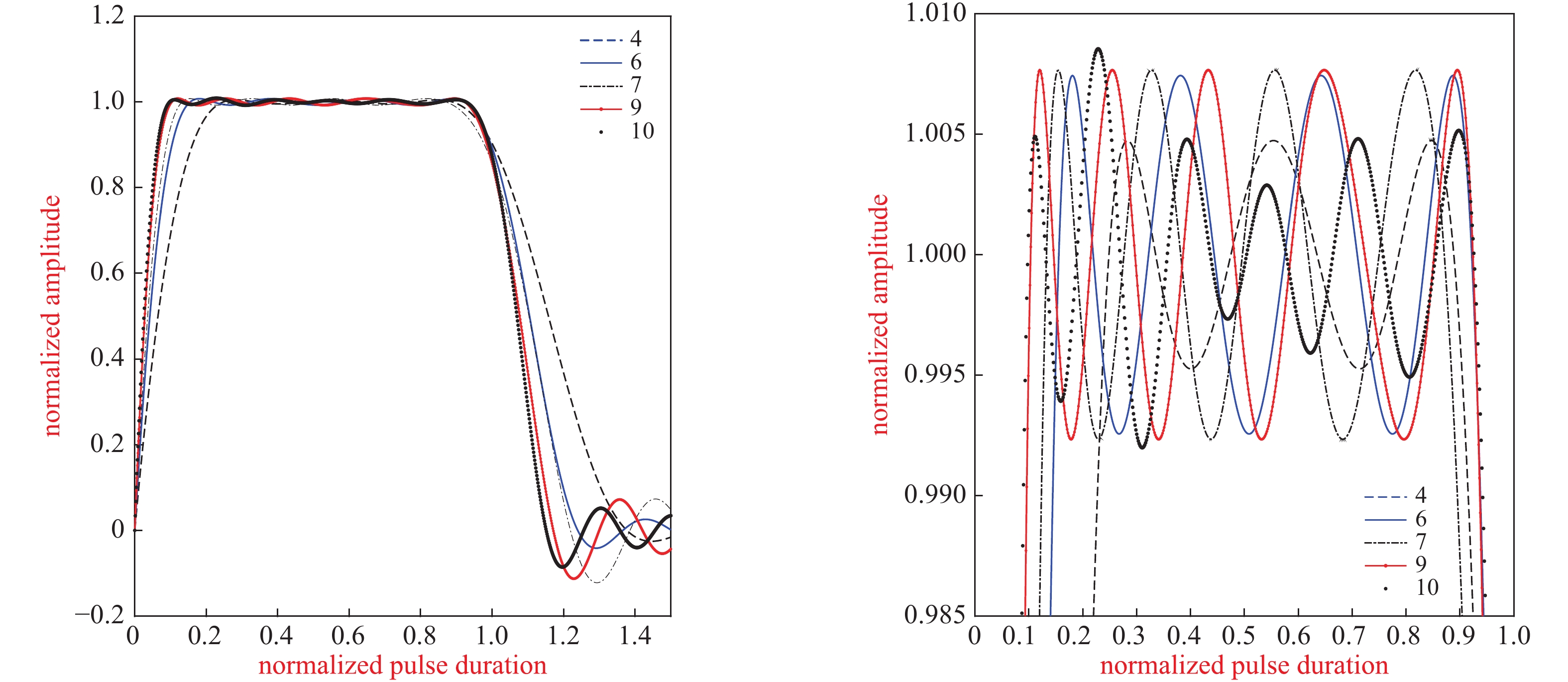Design of trapezoidal pulse forming network based on simplex optimization method
-
摘要: 脉冲形成网络常用于大功率固态调制器、微波驱动源以及激光激励源中,以便获取宽平顶的高压长脉冲输出。针对常用的雷利网络,根据宽平顶低纹波的应用需求,开展了优化设计技术研究,提出了基于单纯形优化法的设计算法。主要针对两种情形进行了优化设计及计算:一是电容值相等,通过优化电感值以获取最优的输出波形;二是约定电容值(电容值不完全相等),通过优化计算不同电容排列下的输出结果,寻求最优的电容排列组合及相应的优化电感值。上述优化算法结果表明,在两种情形下均可以获得较优的准方波脉冲输出,可以为准方波脉冲形成网络的工程实现提供一种新的方法。理论计算和电路仿真结果表明,所提出的方法合理可行。Abstract: Pulse forming network (PFN) is often used in high-power solid-state modulator, microwave driver and laser exciter to obtain high voltage and long pulse output with wide flat-top. Aiming at the common used Rayleigh PFN with equal inductor and capacitor, according to the application requirement of wide flat-top and low ripple, the optimal design technology of PFN is studied, and the optimization algorithm based on simplex optimization method is proposed. The work is mainly carried out in two cases: first, the capacitance is uniform, and the optimal output performance is obtained by optimizing the inductance value; second, the capacitors are constrained, and through optimizing the inductance values under different capacitance arrangement, the optimal capacitance arrangement and the corresponding inductance value are worked out. The optimization results show that the quasi-square-wave pulse output can be obtained in both cases. A new method for design and engineering implementation of quasi-square-wave PFN can be provided. The theoretical calculation and circuit simulation results indicate that the proposed method is reasonable and practicable.
-
表 1 等电容网络电感优化设计值
Table 1. Design value of inductance in PFN with equal capacitors
N C/μF L1/μH L2/μH L3/μH L4/μH L5/μH L6/μH L7/μH L8/μH 5 0.1 0.170 641 0.096 995 0.101 312 0.099 474 0.089 529 —— —— —— 8 0.062 5 0.108 705 0.060 251 0.063 122 0.062 530 0.062 375 0.061 563 0.076 282 0.000 026 表 2 基于5只电容的脉冲形成网络优化后元件参数
Table 2. Parameters of the optimized inductances of PFN with five specified capacitors
No. C1/μF C2/μF C3/μF C4/μF C5/μF L1/μH L2/μH L3/μH L4/μH L5/μH 1 0.092 8 0.087 5 0.097 0 0.109 0 0.114 0 0.168 2 0.085 92 0.091 10 0.105 4 0.096 49 2 0.092 8 0.087 5 0.097 0 0.114 0 0.109 0 0.168 4 0.085 93 0.090 94 0.106 7 0.102 2 3 0.087 5 0.092 8 0.109 0 0.097 0 0.114 0 0.145 8 0.087 11 0.099 80 0.118 4 0.053 55 4 0.087 5 0.092 8 0.109 0 0.114 0 0.097 0 0.146 2 0.087 04 0.099 58 0.121 7 0.060 45 -
[1] 龙霞锋, 刘永贵. Marx型脉冲形成网络的研究[J]. 中国物理C, 2008, 32(s1):274-276. (Long Xiafeng, Liu Yonggui. Investigation of Marx-PFN[J]. Chinese Physics C, 2008, 32(s1): 274-276 [2] 李志强, 杨建华, 张建德, 等. 紧凑重频PFN-Marx脉冲发生器[J]. 强激光与粒子束, 2016, 28:015013. (Li Zhiqiang, Yang Jianhua, Zhang Jiande, et al. A compact repetitive PFN-Marx generator[J]. High Power Laser and Particle Beams, 2016, 28: 015013 doi: 10.11884/HPLPB201628.015013 [3] 黄华, 范植开, 马乔生, 等. 长脉冲相对论速调管放大器的初步实验研究[J]. 强激光与粒子束, 2002, 14(6):915-919. (Huang Hua, Fan Zhikai, Ma Qiaosheng, et al. Progress on a long pulse relativistic klystron amplifier[J]. High Power Laser and Particle Beams, 2002, 14(6): 915-919 [4] 田锦昌, 宋小泉, 李自良. HPM脉冲形成网络的理论分析与计算[J]. 飞行器测控学报, 2003, 22(3):72-74. (Tian Jinchang, Song Xiaoquan, Li Ziliang. Theoretical analysis and calculation of HPM pulse forming network[J]. Journal of Spacecraft TT&C Technology, 2003, 22(3): 72-74 [5] 吴谨, 万重怡. 紫外预电离TE(A)CO2激光器自持辉光放电的阻抗计算[J]. 激光杂志, 2002, 23(2):15-17. (Wu Jin, Wan Chongyi. Calculation of the glow discharge impedance of a UV - preionized self- sustained TE(A) CO2 laser[J]. Laser Journal, 2002, 23(2): 15-17 doi: 10.3969/j.issn.0253-2743.2002.02.005 [6] Smith P W. Transient electronics: pulsed circuit technology[M]. England: John Wiley & Sons Ltd, 2002: 107-136. [7] 刘锡三. 高功率脉冲技术[M]. 北京: 国防工业出版社, 2005: 116-119.Liu Xisan. High pulsed power technology[M]. Beijing: National Defense Industry Press, 2005: 116-119 [8] 李洪涛, 王传伟, 王凌云, 等. 500 kV全固态Marx发生器[J]. 强激光与粒子束, 2012, 24(4):917-920. (Li Hongtao, Wang Chuanwei, Wang Lingyun, et al. 500 kV all-solid-state Marx generator[J]. High Power Laser and Particle Beams, 2012, 24(4): 917-920 doi: 10.3788/HPLPB20122404.0917 [9] 赵娟, 李博婷, 王传伟, 等. 基于波形构型分析的脉冲电路设计方法研究[J]. 强激光与粒子束, 2017, 29:125002. (Zhao Juan, Li Boting, Wang Chuanwei, et al. Design of pulsed power circuit based on waveform analysis[J]. High Power Laser and Particle Beams, 2017, 29: 125002 doi: 10.11884/HPLPB201729.170402 [10] 王传伟, 李洪涛. 准方波脉冲形成网络的理论分析与设计[J]. 强激光与粒子束, 2018, 30:035005. (Wang Chuanwei, Li Hongtao. Theoretical analysis and design of the trapezoidal pulse forming network[J]. High Power Laser and Particle Beams, 2018, 30: 035005 doi: 10.11884/HPLPB201830.170392 [11] 潘子龙, 杨建华, 程新兵. 两节反谐振式网络输出方波脉冲的参数计算[J]. 强激光与粒子束, 2016, 28:045008. (Pan Zilong, Yang Jianhua, Cheng Xinbing. Parameter calculation of square pulse output in two-node anti-resonance network[J]. High Power Laser and Particle Beams, 2016, 28: 045008 doi: 10.11884/HPLPB201628.125008 [12] 王传伟, 李洪涛. 基于互耦电感的两节准方波脉冲形成网络设计[J]. 强激光与粒子束, 2019, 31:040006. (Wang Chuanwei, Li Hongtao. Design of two-stage square pulse forming network with coupling inductors[J]. High Power Laser and Particle Beams, 2019, 31: 040006 doi: 10.11884/HPLPB201931.180299 [13] 王朋, 李名加, 康强, 等. L型脉冲形成网络的仿真与实验研究[J]. 强激光与粒子束, 2013, 25(9):2461-2465. (Wang Peng, Li Mingjia, Kang Qiang, et al. Simulation and experimental research on L-type pulse forming network[J]. High Power Laser and Particle Beams, 2013, 25(9): 2461-2465 doi: 10.3788/HPLPB20132509.2461 [14] 程道国. 脉冲形成网络设计中的若干问题[J]. 现代电子, 1998, 63(2):22-27. (Chen Daoguo. Some problem in design of pulse forming network[J]. Modern Electronics, 1998, 63(2): 22-27 [15] 龙霞锋. Marx型脉冲形成网络研究[D]. 长沙: 国防科技大学, 2007: 5-21.Long Xiafeng. Investigation of Marx-PFN[D]. Changsha: National University of Defense Technology, 2007: 5-21 [16] 谢政, 李建平, 陈挚. 非线性最优化理论与方法[M]. 北京: 高等教育出版社, 2010.Xie zheng, Li Jianping, Chen Zhi. Nonlinear optimization theory and methods. Beijing: Higher Education Press, 2010 [17] 刘亚康. 时域逼近[M]. 北京: 高等教育出版社, 1993: 186-191.Liu Yakang. Time domain approximation[M]. Beijing: Higher Education Press, 1993: 186-191 -





 下载:
下载:






